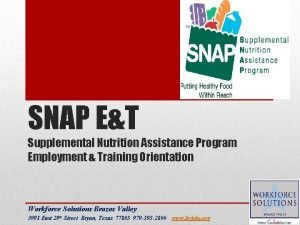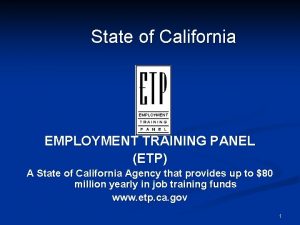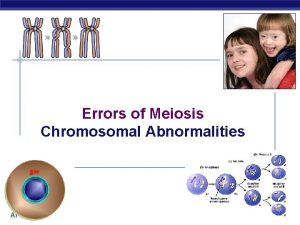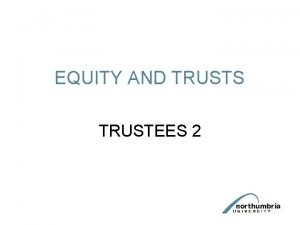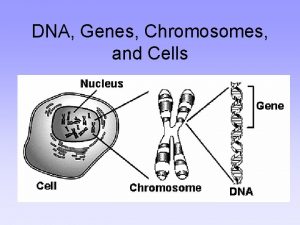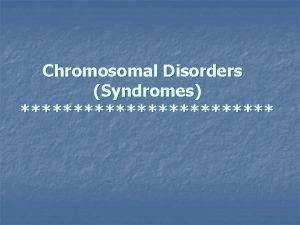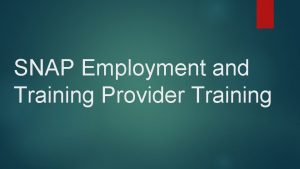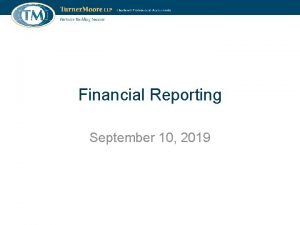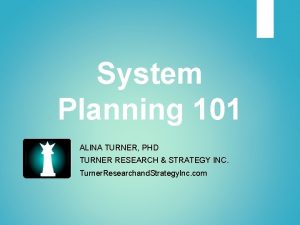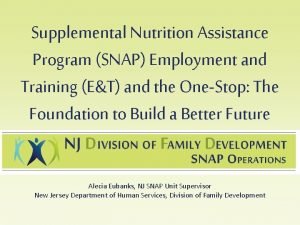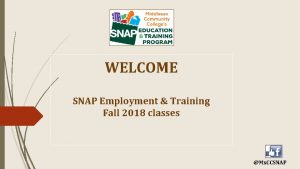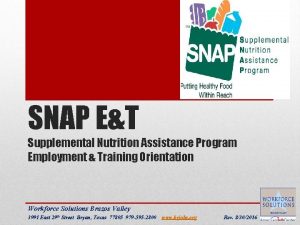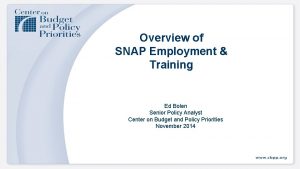SNAP Employment Training SNAP ET Jason Turner Christine

























- Slides: 25

SNAP Employment & Training (SNAP E&T) Jason Turner & Christine Ruggieri USDA FNS Employment & Training Analysts Mid-West and Eastern WIOA Regional Conference Presented on November 6 & 8, 2017

The Mission for America’s Food Security Programs: Food, Nutrition, Consumer Services Vision: To End Hunger and Improve Nutrition in America Food Nutrition Service Mission: We work with partners to provide food and nutrition education to people in need in a way that inspires public confidence and supports American agriculture. 2

FNS is a nutrition agency Then why are we here talking to you about employment? 3

Purpose of the SNAP Employment and Training (E&T) Program To assist members of SNAP households in gaining skills, training, work, or experience that will increase their ability to obtain regular employment. Section 6(d)(4) of the Food and Nutrition Act 4

What is SNAP E&T? • USDA provides ~$400 million annually to states to operate SNAP Employment and Training programs. • All states are required to operate E&T programs. • Serves 634, 000 SNAP participants annually. • States have flexibility in designing E&T programs that meet the needs of participants and employers. 5

Why SNAP E&T matters • Nearly two-thirds of jobs will require a postsecondary education by 2020. • Expanding access to education and training helps low-income, lowskilled SNAP recipients transition into familysupporting employment and reduce their need for SNAP. 6

Who is Eligible for SNAP E&T? • SNAP participants who: – Are receiving SNAP in the month they participate in a component*; – Do not receive TANF cash assistance; and – Not receiving Commodities/FDPIR – Are able to work upon program completion. • States can operate mandatory or voluntary programs. *Except for job retention services, which can be provided for up to 90 days post-employment even if the individual loses eligibility for SNAP. 7

Top Priorities for E&T • Increasing capacity at national, State, and local level • Driving investments toward in employer-driven employment and training programs • Applying best practices to help move SNAP participants into good jobs • Fostering Tribal partnerships

What Services are Provided through E&T? • An E&T program is a package of services: – Assessment, – Component activities, – Participant reimbursements (e. g. dependent care, transportation, books, supplies), and – Follow-up. • State agencies choose the activities (“components”) they will offer (or partner with others to offer) and articulate them in the annual state plan. 9

E&T “Components” • Job search and job search training (work readiness) • Workfare; • Programs designed to improve the employability of individuals through actual work experience, training, or both; • Programs designed to increase an individual’s self-sufficiency through self-employment; • Education that improve basic skills or employability and have a direct link to employment; • Career and technical/vocational training; and • Job retention for 90 days following employment. 10

Mandatory v. Voluntary Participants Mandatory • Are required by the state to participate in an E&T program as a condition of receiving SNAP. • Can be sanctioned for non-participation Voluntary • Are not required to participate but do so voluntarily • Cannot be sanctioned for nonparticipation. • 34 states operate allvolunteer programs. 11

E&T Funding

SNAP E&T Funding: A Snapshot States are not currently maximizing their use of E&T funds Federal SNAP E&T Funding 100 Percent Funds Pledge State (ABAWD) Funds* 50 -50 and 75% Funds Administrative Reimbursements Participant Reimbursements There are three major SNAP E&T funding streams 50 -50 funds are extremely flexible * States that agree to serve all childless adults in the state receive a proportionate share of $20 million in addition to the 100 percent funds. 13

100 Percent Funds • $90 million allocated annually to all States, based on a formula • Must be used for planning, implementation, and operation of a state E&T program • Costs covered include: administrative expenses, case management, direct services, and others • Funds can be used by SNAP administering agency or by contract with E&T training providers such as workforce agencies, CBOs, and community colleges 14

75% Federal Reimbursement to Tribes • Where the real potential for growth in the program is! • Covers both administrative costs and participant reimbursements (transportation, child care, books, supplies, etc. ) • FNS reimburses 75 percent of costs spent on E&T by Tribal Agencies 15

How You Get Involved

Become A Partner • Talk to your State SNAP Agency to see their current offerings and how you can contract as a partner • Connect your other anti-poverty, work development, and selfsufficiency initiatives to SNAP E&T • Build partnerships with employers to help them recruit from your community • Identify potential funding opportunities to grow the program 17

What Services You Would Provide • Explain SNAP E&T and other opportunities available to current and potential SNAP recipients • Identify barriers to employment and create a plan to solve • Provide job search, education, and other components 18

SNAP E&T Builds Capacity • Connect the dots between already established education and training programs, health, housing, legal and other supportive services available in the community • Add federal funding to your programs • Improve/expand your employment programs that can enhance existing efforts: – Basic work and life-skills trainings – Matchmaking services between employers and job seekers – Professional clothing closet – Write scripts and train volunteers to run mock interviews – Connecting participants to formal education 19

Where do I start?

1. Educate Yourself • E&T Resource Center (www. fns. usda. gov) – USDA’s SNAP Employment and Training Toolkit – SNAP To Skills • Read articles from: – National Skills Coalition – CLASP • Northwest Indian College E&T program – Lummi Nation in Washington State 21

2. Familiarize yourself with your State’s Program and Structure • Read your State’s plan • Contact your State agency and the SNAP E&T partners working in your community • Ask to shadow SNAP E&T agencies/staff 22

10/28/2020 23

Regional SNAP E&T Contacts • Christine Ruggieri (NERO) Mary. Ruggieri@fns. usda. gov • Derrick Dolphin (MARO) derrick. dolphin@fns. usda. gov • Nick Espinosa (SERO) Nick. Espinosa@fns. usda. gov • Jason Turner (SWRO) Jason. M. Turner@fns. usda. gov • Karla Maraccini (MPRO) karla. maraccini@fns. usda. gov • Brian Solomon (WRO) Brian. Solomon@fns. usda. gov Ray Prendergast (MWRO) raymond. prendergast@fns. usda. gov • 24

Contact Us Jason Turner 214 -290 -9952 Jason. M. Turner@fns. usda. gov Christine Ruggieri 617 -565 -5925 Christine. Ruggieri@fns. usda. gov 25
 What does abawd mean
What does abawd mean Filing snap fit snap partner maylundentechcrunch
Filing snap fit snap partner maylundentechcrunch Employment training panel sacramento
Employment training panel sacramento Anishinabek employment and training services
Anishinabek employment and training services Gila river employment and training
Gila river employment and training Jennie turner
Jennie turner Trompenaars and hampden-turner cultural dimensions
Trompenaars and hampden-turner cultural dimensions Whitted ray tracer
Whitted ray tracer Glen turner the malt legend
Glen turner the malt legend 46 chromosomes
46 chromosomes Klinefelter syndrome facial features
Klinefelter syndrome facial features Turner syndrome is what numerical chromosome disorder?
Turner syndrome is what numerical chromosome disorder? Kleinfelters syndrome
Kleinfelters syndrome Southwestern province kappa alpha psi
Southwestern province kappa alpha psi Syndrome de parsonage-turner
Syndrome de parsonage-turner Alina luca
Alina luca Patau syndrome
Patau syndrome Turner syndrome is what numerical chromosome disorder?
Turner syndrome is what numerical chromosome disorder? Turner v corney
Turner v corney Multiview bom
Multiview bom Turner syndrome karyotype
Turner syndrome karyotype Turner incisor
Turner incisor Backhus windrow turner factory
Backhus windrow turner factory Jay contoy cnn
Jay contoy cnn Turner syndrome symptoms
Turner syndrome symptoms Turner syndrome symptoms
Turner syndrome symptoms
